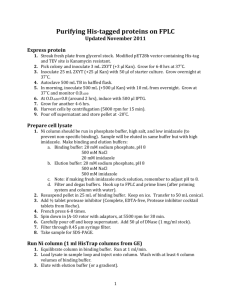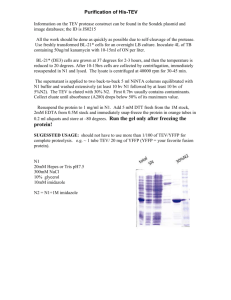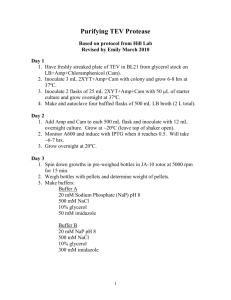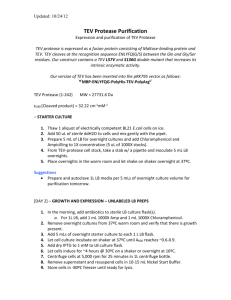TEV-Protease
advertisement
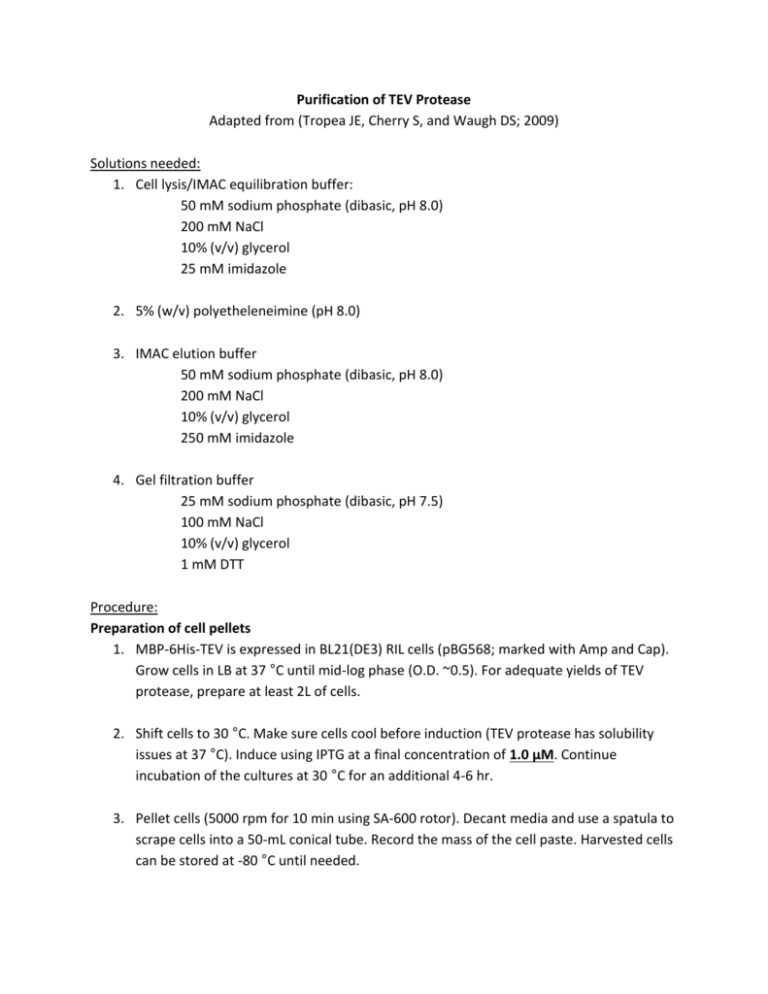
Purification of TEV Protease Adapted from (Tropea JE, Cherry S, and Waugh DS; 2009) Solutions needed: 1. Cell lysis/IMAC equilibration buffer: 50 mM sodium phosphate (dibasic, pH 8.0) 200 mM NaCl 10% (v/v) glycerol 25 mM imidazole 2. 5% (w/v) polyetheleneimine (pH 8.0) 3. IMAC elution buffer 50 mM sodium phosphate (dibasic, pH 8.0) 200 mM NaCl 10% (v/v) glycerol 250 mM imidazole 4. Gel filtration buffer 25 mM sodium phosphate (dibasic, pH 7.5) 100 mM NaCl 10% (v/v) glycerol 1 mM DTT Procedure: Preparation of cell pellets 1. MBP-6His-TEV is expressed in BL21(DE3) RIL cells (pBG568; marked with Amp and Cap). Grow cells in LB at 37 °C until mid-log phase (O.D. ~0.5). For adequate yields of TEV protease, prepare at least 2L of cells. 2. Shift cells to 30 °C. Make sure cells cool before induction (TEV protease has solubility issues at 37 °C). Induce using IPTG at a final concentration of 1.0 μM. Continue incubation of the cultures at 30 °C for an additional 4-6 hr. 3. Pellet cells (5000 rpm for 10 min using SA-600 rotor). Decant media and use a spatula to scrape cells into a 50-mL conical tube. Record the mass of the cell paste. Harvested cells can be stored at -80 °C until needed. Purification of TEV protease 1. Let frozen cell pellets thaw slightly. Add 50 μL each of Pepstatin A and aqueous protease inhibitors; vortex. 2. Once cell pellets are soft, add ice-cold “Cell lysis/IMAC equilibration” buffer (10 mL buffer per 1 g cell paste). Vortex and invert until no visible clumps of cells remain. 3. Add some lysozyme. Vortex and invert several times. Incubate cells on ice for 10-15 min or until noticeably viscous. 4. Sonicate cells for 30-45 s intervals. Allow cells to cool on ice for ~60 s between sonication intervals. Repeat 3 times, or as needed until the viscosity of the lysate is noticeably reduced. 5. Note the volume of cell lysate in the tube at add “5% (w/v) polyetheleneimine (pH 8.0)” to a final concentration of 0.1 % (1:50 dilution). Mix by inverting several times. 6. Centrifuge cell lysates at 15,000 x g (~11,500 rpm using SA-600 rotor) for 30 min at 4 °C. Be sure that the rotor has been pre-chilled before proceeding with this step. Determine the volume of the supernatant. 7. Wash a fresh “HisTrap HP” column with 5 CV of “Cell lysis/IMAC equilibration” buffer. (Important: The HisTrap HP columns come in either a 1-mL or 5-mL size. If using the 1mL size do not load more than ~25 mL of medium-speed supernatant (MSS) on the column at once. A greater volume will exceed the binding capacity of the Ni-NTA beads.) 8. Load MSS onto HisTrap column using the super loop. The max pressure for a HisTrap column is 0.3 MPa; this allows for a flow-rate of ~0.5 mL/min. Run the FPLC manually and be sure that the “V1_Inject” box on the FPLC software is set to “Inject”, NOT “Load”. 9. While the MSS is being loaded onto the HisTrap column, pull the tubing out of the waste flask and place into a clean 50-mL conical tube. Save the flow-thru (FT) that collects and set aside the tube for later. 10. After all of the MSS has been loaded onto the HisTrap column, swap the tubing from the 50-mL conical tube that was collecting the FT to a fresh conical tube. Manually wash the HisTrap column with 5 CV of “Cell lysis/IMAC equilibration” buffer. Save the wash sample that collects in the conical tube. After washing the HisTrap column, place the FPLC tubing back into the side-arm waste flask. 11. Elute the TEV protease from the HisTrap column using a linear gradient from 0% to 100% “IMAC elution” buffer over 10 CV. Collect 1 mL fractions (10 total). 12. Wash the HisTrap column with 5 CV of 100% “IMAC elution” buffer. Collect 1 mL fractions (5 total). 13. Check all 15 elution fractions, the FT, and the wash sample for the presence of TEV protease using SDS-PAGE. In the elution fractions, there should be 2 major products visible: TEV protease (~28 kDa) and MBP (~45 kDa). Pool only the elution fractions that have a much higher amount of TEV vs. MBP. (Note: In my experience, the peak fractions are ~6-11.) 14. Optional: If there is a significant amount of TEV visible in the FT or wash sample, repeat Steps 7-12 using the FT/wash sample in place of the MSS. 15. If the total volume of MSS collected in Step 6 exceeded 25 mL, repeat steps 7-14 using 25 mL increments of MSS until all of it has passed over the HisTrap column. 16. Combine all pooled fractions and concentrate using a membrane with a molecular weight cut-off (MWCO) of 10 kDa until the volume of protein is < 3 mL. (Note: The final volume of concentrated protein assumes that an S200 column will be used for the subsequent gel-filtration step. If using a different column, concentrate the protein such that the amount of protein to be added to the gel-filtration column does not exceed ~2% of the total column volume.) 17. To the concentrated protein sample, add 1000 mM DTT to a final concentration of 1 mM. Centrifuge the sample at 5000 x g for 10 min to pellet any precipitate that may be present. 18. Load the protein sample onto an S200 column equilibrated with “Gel filtration” buffer. Use a flow-rate of 0.2-0.3 mL/min and collect 1.5 mL fractions. Be sure that no MBP comigrated with the TEV and combine peak fractions (Note: Peak fractions should occur around #48-59). Concentrate pooled fractions until TEV is present at 1-5 mg/mL. Flashfreeze in liquid nitrogen and store at -80 °C.
